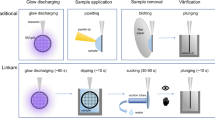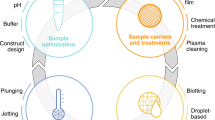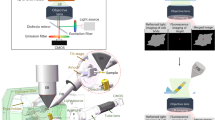Abstract
Cryo-electron tomography (CET) of fully hydrated, vitrified biological specimens has emerged as a vital tool for biological research. For cellular studies, the conventional imaging modality of transmission electron microscopy places stringent constraints on sample thickness because of its dependence on phase coherence for contrast generation. Here we demonstrate the feasibility of using scanning transmission electron microscopy for cryo-tomography of unstained vitrified specimens (CSTET). We compare CSTET and CET for the imaging of whole bacteria and human tissue culture cells, finding favorable contrast and detail in the CSTET reconstructions. Particularly at high sample tilts, the CSTET signals contain more informative data than energy-filtered CET phase contrast images, resulting in improved depth resolution. Careful control over dose delivery permits relatively high cumulative exposures before the onset of observable beam damage. The increase in acceptable specimen thickness broadens the applicability of electron cryo-tomography.
This is a preview of subscription content, access via your institution
Access options
Subscribe to this journal
Receive 12 print issues and online access
$259.00 per year
only $21.58 per issue
Buy this article
- Purchase on Springer Link
- Instant access to full article PDF
Prices may be subject to local taxes which are calculated during checkout





Similar content being viewed by others
References
Medalia, O. et al. Macromolecular architecture in eukaryotic cells visualized by cryoelectron tomography. Science 298, 1209–1213 (2002).
Milne, J.L. & Subramaniam, S. Cryo-electron tomography of bacteria: progress, challenges and future prospects. Nat. Rev. Microbiol. 7, 666–675 (2009).
Bharat, T.A. et al. Cryo-electron tomography of Marburg virus particles and their morphogenesis within infected cells. PLoS Biol. 9, e1001196 (2011).
Diebolder, C.A., Koster, A.J. & Koning, R.I. Pushing the resolution limits in cryo electron tomography of biological structures. J. Microsc. 248, 1–5 (2012).
Gan, L. & Jensen, G.J. Electron tomography of cells. Q. Rev. Biophys. 45, 27–56 (2012).
Dubochet, J., Lepault, J., Freeman, R., Berriman, J.A. & Homo, J.C. Electron microscopy of frozen water and aqueous solutions. J. Microsc. 128, 219–237 (1982).
Al-Amoudi, A. et al. Cryo-electron microscopy of vitreous sections. EMBO J. 23, 3583–3588 (2004).
Schertel, A. et al. Cryo FIB-SEM: volume imaging of cellular ultrastructure in native frozen specimens. J. Struct. Biol. 184, 355–360 (2013).
Danev, R., Kanamaru, S., Marko, M. & Nagayama, K. Zernike phase contrast cryo-electron tomography. J. Struct. Biol. 171, 174–181 (2010).
Murata, K. et al. Zernike phase contrast cryo-electron microscopy and tomography for structure determination at nanometer and subnanometer resolutions. Structure 18, 903–912 (2010).
Philippsen, A., Engel, H.A. & Engel, A. The contrast-imaging function for tilted specimens. Ultramicroscopy 107, 202–212 (2007).
Jones, A.V. & Leonard, K.R. Scanning-transmission electron microscopy of unstained biological sections. Nature 271, 659–660 (1978).
Kellenberger, E. et al. Z-Contrast in biology—a comparison with other imaging modes. Ann. NY Acad. Sci. 483, 202–228 (1986).
Colliex, C., Mory, C., Olins, A.L., Olins, D.E. & Tence, M. Energy filtered STEM imaging of thick biological sections. J. Microsc. 153, 1–21 (1989).
Takaoka, A. & Hasegawa, T. Observations of unstained biological specimens using a low-energy, high-resolution STEM. J. Electron Microsc. (Tokyo) 55, 157–163 (2006).
Hohmann-Marriott, M.F. et al. Nanoscale 3D cellular imaging by axial scanning transmission electron tomography. Nat. Methods 6, 729–731 (2009).
Aoyama, K., Takagi, T., Hirase, A. & Miyazawa, A. STEM tomography for thick biological specimens. Ultramicroscopy 109, 70–80 (2008).
Yakushevska, A.E. et al. STEM tomography in cell biology. J. Struct. Biol. 159, 381–391 (2007).
Buban, J.P., Ramasse, Q., Gipson, B., Browning, N.D. & Stahlberg, H. High-resolution low-dose scanning transmission electron microscopy. J. Electron Microsc. (Tokyo) 59, 103–112 (2010).
Cowley, J.M. & Moodie, A.F. The scattering of electrons by atoms and crystals. II. The effects of finite source size. Acta Crystallogr. 12, 353–359 (1959).
de Jonge, N., Peckys, D.B., Kremers, G.J. & Piston, D.W. Electron microscopy of whole cells in liquid with nanometer resolution. Proc. Natl. Acad. Sci. USA 106, 2159–2164 (2009).
Peckys, D.B. & de Jonge, N. Visualizing gold nanoparticle uptake in live cells with liquid scanning transmission electron microscopy. Nano Lett. 11, 1733–1738 (2011).
Cowley, J.M., Hansen, M.S. & Wang, S.Y. Imaging modes with an annular detector in STEM. Ultramicroscopy 58, 18–24 (1995).
Findlay, S.D. et al. Robust atomic resolution imaging of light elements using scanning transmission electron microscopy. Appl. Phys. Lett. 95, 191913 (2009).
Tocheva, E.I. et al. Polyphosphate storage during sporulation in the gram-negative bacterium Acetonema longum. J. Bacteriol. 195, 3940–3946 (2013).
Engel, A. in Advances in Imaging and Electron Physics Vol. 159 (ed. Hawkes, P.W.) 357–386 (Elsevier, 2009).
Baker, L.A. & Rubinstein, J.L. Radiation damage in electron cryomicroscopy. Methods Enzymol. 481, 371–388 (2010).
Baker, L.A., Smith, E.A., Bueler, S.A. & Rubinstein, J.L. The resolution dependence of optimal exposures in liquid nitrogen temperature electron cryomicroscopy of catalase crystals. J. Struct. Biol. 169, 431–437 (2010).
Comolli, L.R. & Downing, K.H. Dose tolerance at helium and nitrogen temperatures for whole cell electron tomography. J. Struct. Biol. 152, 149–156 (2005).
Downing, K.H. Spot-scan imaging in transmission electron microscopy. Science 251, 53–59 (1991).
Colliex, C. & Mory, C. Scanning-transmission electron microscopy of biological structures. Biol. Cell 80, 175–180 (1994).
Shibata, N. et al. New area detector for atomic-resolution scanning transmission electron microscopy. J. Electron Microsc. (Tokyo) 59, 473–479 (2010).
Sousa, A.A., Azari, A.A., Zhang, G.F. & Leapman, R.D. Dual-axis electron electron tomography of biological specimens: extending the limits of specimen thickness with bright-field STEM imaging. J. Struct. Biol. 174, 107–114 (2011).
Zheng, S.Q., Sedat, J.W. & Agard, D.A. in Methods in Enzymology Vol. 481 (ed. Jensen, G.J.) 283–315 (Academic Press, 2010).
Guesdon, A., Blestel, S., Kervrann, C. & Chrétien, D. Single versus dual-axis cryo-electron tomography of microtubules assembled in vitro: limits and perspectives. J. Struct. Biol. 181, 169–178 (2013).
Myasnikov, A.G., Afonina, Z.A. & Klaholz, B.P. Single particle and molecular assembly analysis of polyribosomes by single- and double-tilt cryo electron tomography. Ultramicroscopy 126, 33–39 (2013).
Dubey, G.P. & Ben-Yehuda, S. Intercellular nanotubes mediate bacterial communication. Cell 144, 590–600 (2011).
Ducret, A., Fleuchot, B., Bergam, P. & Mignot, T. Direct live imaging of cell-cell protein transfer by transient outer membrane fusion in Myxococcus xanthus. Elife 2, e00868 (2013).
Remis, J.P. et al. Bacterial social networks: structure and composition of Myxococcus xanthus outer membrane vesicle chains. Environ. Microbiol. 16, 598–610 (2014).
Kremer, J.R., Mastronarde, D.N. & McIntosh, J.R. Computer visualization of three-dimensional image data using IMOD. J. Struct. Biol. 116, 71–76 (1996).
Agulleiro, J.I. & Fernandez, J.J. Fast tomographic reconstruction on multicore computers. Bioinformatics 27, 582–583 (2011).
Cowley, J.M. & Moodie, A.F. The scattering of electrons by atoms and crystals. II. The effects of finite source size. Acta Crystallogr. 12, 353–359 (1959).
Barthel, J. Time-efficient frozen phonon multislice calculations for image simulations in high-resolution STEM in. Proc. of the 15th Euro. Microsc. Cong. (Journal of Microscopy, 2012).
Metropolis, N., Rosenbluth, A.W., Rosenbluth, M.N., Teller, A.H. & Teller, E. Equation of state calculations by fast computing machines. J. Chem. Phys. 21, 1087–1092 (1953).
Weickenmeier, A. & Kohl, H. Computation of absorptive form-factors for high-energy electron-diffraction. Acta Cryst. 47, 590–597 (1991).
Loane, R.F., Xu, P.R. & Silcox, J. Thermal vibrations in convergent-beam electron-diffraction. Acta Cryst. 47, 267–278 (1991).
Acknowledgements
We thank A. Teitelboim and G. Bellapadrona for preparation of samples. U2OS cells were a kind gift from B. Geiger (Weizmann Institute of Science). M.E. thanks P. Christie (University of Texas, Houston Medical School) for collaboration on Agrobacterium structures, which was supported by the US Israel Binational Agricultural Research and Development Fund. Electron microscopy was performed at the Irving and Cherna Moskowitz Center for Nano and Bio-Nano Imaging at the Weizmann Institute of Science. This work was additionally supported by the Gerhardt M.J. Schmidt Minerva Center for Supramolecular Architecture. The lab of M.E. has benefited from the historical generosity of the Harold Perlman family.
Author information
Authors and Affiliations
Contributions
S.G.W., L.H. and M.E. designed the experiments. S.G.W. and L.H. performed experiments. S.G.W., L.H. and M.E. analyzed the data. L.H. performed the simulation calculations. S.G.W., L.H. and M.E. wrote the manuscript.
Corresponding authors
Ethics declarations
Competing interests
The authors declare no competing financial interests.
Supplementary information
Supplementary Text and Figures
Supplementary Figures 1–7 and Supplementary Table 1 (PDF 2895 kb)
Source data
Rights and permissions
About this article
Cite this article
Wolf, S., Houben, L. & Elbaum, M. Cryo-scanning transmission electron tomography of vitrified cells. Nat Methods 11, 423–428 (2014). https://doi.org/10.1038/nmeth.2842
Received:
Accepted:
Published:
Issue Date:
DOI: https://doi.org/10.1038/nmeth.2842



